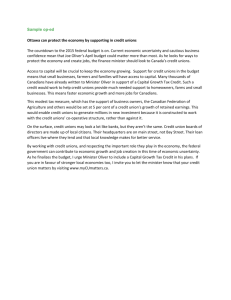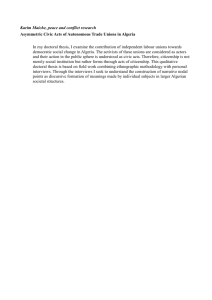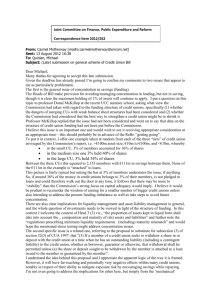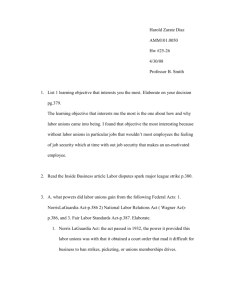1) Identify the problem area
advertisement
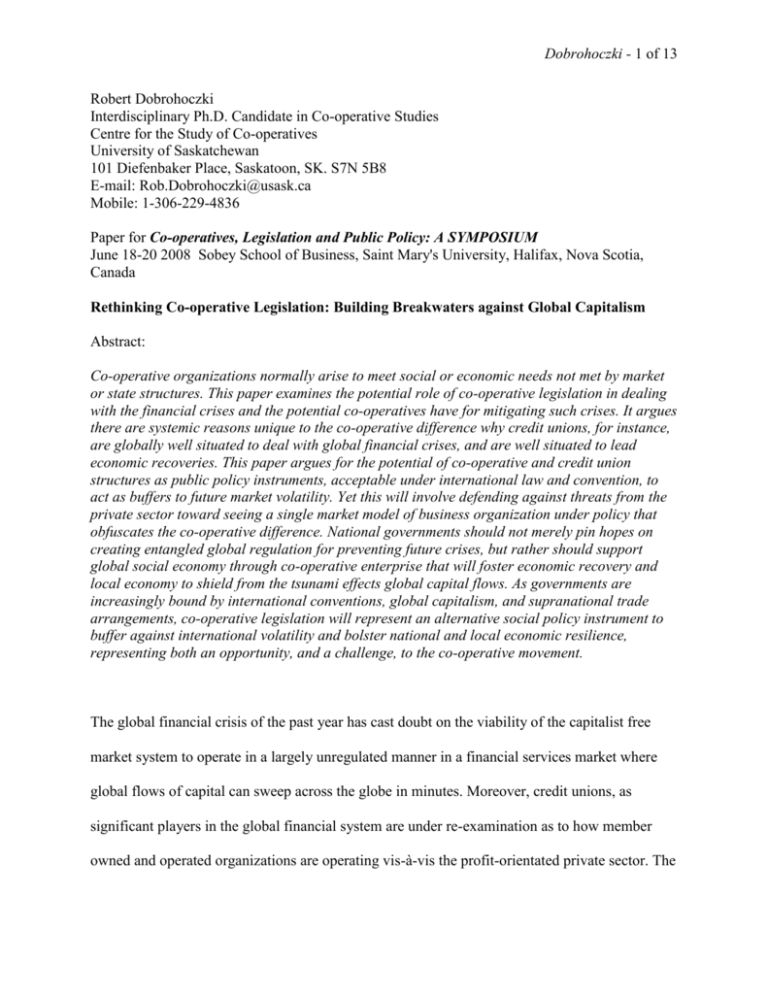
Dobrohoczki - 1 of 13 Robert Dobrohoczki Interdisciplinary Ph.D. Candidate in Co-operative Studies Centre for the Study of Co-operatives University of Saskatchewan 101 Diefenbaker Place, Saskatoon, SK. S7N 5B8 E-mail: Rob.Dobrohoczki@usask.ca Mobile: 1-306-229-4836 Paper for Co-operatives, Legislation and Public Policy: A SYMPOSIUM June 18-20 2008 Sobey School of Business, Saint Mary's University, Halifax, Nova Scotia, Canada Rethinking Co-operative Legislation: Building Breakwaters against Global Capitalism Abstract: Co-operative organizations normally arise to meet social or economic needs not met by market or state structures. This paper examines the potential role of co-operative legislation in dealing with the financial crises and the potential co-operatives have for mitigating such crises. It argues there are systemic reasons unique to the co-operative difference why credit unions, for instance, are globally well situated to deal with global financial crises, and are well situated to lead economic recoveries. This paper argues for the potential of co-operative and credit union structures as public policy instruments, acceptable under international law and convention, to act as buffers to future market volatility. Yet this will involve defending against threats from the private sector toward seeing a single market model of business organization under policy that obfuscates the co-operative difference. National governments should not merely pin hopes on creating entangled global regulation for preventing future crises, but rather should support global social economy through co-operative enterprise that will foster economic recovery and local economy to shield from the tsunami effects global capital flows. As governments are increasingly bound by international conventions, global capitalism, and supranational trade arrangements, co-operative legislation will represent an alternative social policy instrument to buffer against international volatility and bolster national and local economic resilience, representing both an opportunity, and a challenge, to the co-operative movement. The global financial crisis of the past year has cast doubt on the viability of the capitalist free market system to operate in a largely unregulated manner in a financial services market where global flows of capital can sweep across the globe in minutes. Moreover, credit unions, as significant players in the global financial system are under re-examination as to how member owned and operated organizations are operating vis-à-vis the profit-orientated private sector. The Dobrohoczki - 2 of 13 success of the credit union movement globally in withstanding the financial crisis has been remarkable (ICA, 2009a) vis-à-vis the banking sector and institutions that were once thought of as some of the world’s largest financial powerhouses, like Citigroup, now in a state of effective partial nationalization. In the past I have argued that co-operatives can serve as bulwarks and spaces of resistance against capitalism, and promoting the co-operative form serves valid public policy objectives in the promotion of local economy (Dobrohoczki, 2006; 2007). However, one must understand the nature of the specific crisis and the specific nature of global capitalism to understand exactly how co-operative institutions are capable of acting as agents of public policy in their capacity to act as breakwaters in the global tidal flows of capital crises. Global Financial Crisis The underlying causes of the current economic crisis are complex. Much of the current crisis can be traced to U.S. tax code and public policy that allowed unsustainable leveraging of debt into home mortgages, leading to the plethora of debt instruments that intended to diversify the risk of carrying such debt onto the global capital markets (Ely, 2009). The World Council of Credit Unions (WOCCU, 2009) attributes the crisis to the “skyrocketing number of mortgage loan defaults and foreclosures” during the past few years as a primary catalyst, with the drop in housing values “exacerbating the problem.” The primary culprits it argues included sub-prime mortgage loans characterized by high interest rates with large interest-rate re-sets, negative amortization, lack of sufficient underwriting and of course, some indicators of fraud. Dobrohoczki - 3 of 13 Generally credit union movements across the world have faired well in the global financial crisis. The World Council of Credit Unions states that: “Unlike other types of financial institutions, credit unions originated few if any subprime mortgage loans with these characteristics and have not otherwise been the cause of the current economic circumstances. Credit unions’ generally conservative lending practices and philosophical mandate to place member needs ahead of institutional profits have, in effect, restricted financial cooperatives from engaging in careless lending practices and distinguished them from institutions responsible for making unscrupulous loans in recent years.” (WOCCU, 2009: 2) Despite this rosy picture of the credit union situation globally, there have been problems. Amid the talk of the bailout of the major financial institutions worldwide to correct the undercapitalization issues wrought by bad debt, in the United States, there has been a much publicized and mischaracterized talk of a “bailout” of the Credit Union system in the United States (Maremont, 2009). Some of the largest “corporate” or second tier credit unions in the United States have needed “bailout” money in dealing with losses on mortgage-backed securities, endangering the stability of the central organization, the National Credit Union Administration (NCUA) by depleting the National Credit Union Share Insurance Fund. However, it should be noted what is meant by the term “bailout” that has lead to the mischaracterization. The individual member credit unions are for the most part solvent and have not been affected by the financial crises itself (except by the ancillary downturn in the economy in some areas, here we must distinguish between financial and economic crisis). It is the secondtier credit unions that have been in trouble. The bailout proposed by the credit union system is not coming from taxpayers, but from credit unions themselves. Legislative changes were needed Dobrohoczki - 4 of 13 for a Stabilization Plan: to restructure the central organization to handle the more debt from its members rather than tap into government bailout money. What credit unions are asking for is greater legislative flexibility in addressing the balance sheet of the central organization relying on the strength of the member credit unions. This in part was required when the TreasurySecretary Paulson opted for taking direct stakes in banks and other financial institutions rather than providing money through the TARP (Troubled Asset Relief Program) which initially was aimed at buying up illiquid mortgage related assets (Maremont, 2009). The desire of course for credit union autonomy from government necessitated a solution within the system. The American example illustrates a unique aspect of the financial crisis. The larger, more global, the institution, the more exposed to risk it was. One may forgiven for, upon a cursory look at credit unions worldwide (WOCCU, 2009), espousing the superiority of the model. Or attributing the sole success of the credit union model to the fact that as member driven organizations, credit unions are not driven by maximizing profits but instead by servicing the needs of their members. This model has the effect of not giving the CEOs of credit unions as much incentive to exaggerate profits, as in the case of a credit union, the shareholders are the users, and it is the users needs, rather than shareholder returns, that are paramount. Of course, credit union CEOs do not receive stock options either, creating even less incentive to exaggerate profits and by association, inflating stock values. Members can be reasonably certain that mergers among credit unions, for instance, are more about business than stock value. But there is more to the stability of the credit union model during the financial crisis than just the member-owned membercontrolled model of business and the disincentives for personal avarice, and the American situation provides a clue. It is rather the locality of credit unions that has made them insular in Dobrohoczki - 5 of 13 this particular crisis, and it is this unique feature, their connectedness to local economy that makes them a potential public policy instrument against global crises in the future. The Alberta Example in the 1980s To suggest that credit union financial systems are not susceptible to crises would merely be mere hubris. One example with stark comparisons to the current global financial crisis makes this apparent. In the Canadian province of Alberta during the 1980s the credit union system nearly collapsed. Indeed it would have collapsed were it not for a government bailout in the late 1980s, and bailout in terms of taxpayer money loaned to the system, as the system could not sustain itself. Like the global financial crisis, there had been a major speculative bubble in the real estate market in the oil rich economy of Alberta in the years prior to the 1982 recession. When the recession hit, plummeting real estate prices and rising unemployment lead to a large number of mortgage defaults. All financial institutions were effected: the credit union system was forced into a net deficit position and the stabilization system in the central was inadequately funded. Like the global financial crisis, much had been attributed to speculative loans in real estate in the 1970s. The net result was a 300 million dollar (Canadian) bailout loan from Alberta Government that was eventually paid back over and lengthy number of years. (Wylie, 1994) Another common element to the global financial crisis and the Alberta example was a failure of regulation of certain sectors of the financial services industry. There were troubles in certain CDIC (Canada Deposit Insurance Corporation) insured trust companies: North West Trust Company, Principal Savings & Trust, and Heritage Trust. But moreover, there was a collapse of Dobrohoczki - 6 of 13 the investment firms, Associated Investors of Canada (AIC) and First Investors Corp (FIC) in 1987 (Wylie, 1994). These firms were not as regulated as trusts or credit unions and fell completely outside the Alberta Securities Act. Not only that, they were not CDIC insured when in fact, most of their investors actually believed they were. The collapse of these institutions caused an enormous loss in consumer confidence in the sector. Without regulation, they were not adequately capitalized under Investment Contracts Act under which they were enabled. This has direct parallels to the systemic deregulation flaws and undercapitalization in the sub-prime mortgage crisis. Interestingly enough, the financial crisis in Alberta managed to reach right across the financial services industry and negatively impact credit unions. What the Alberta example illustrates is that credit unions can be susceptible to financial crises. Indeed financial crises very much like the global crisis we have seen in the past year, driven by speculative real estate bubbles, accentuated by poorly regulated financial instruments. Several lessons can be learned from the Alberta example. First, much like the current situation in America, there was an overall desire for credit union autonomy even in the depth of crisis. Despite the fact government bailout money was needed, it is important to keep in mind this money was loaned to the Alberta credit union system, and it was in fact eventually paid back (one wonders if current bailouts in the banking sector will see such results). It did not involve government takeovers or increased control of the sector. In the neighboring province of Saskatchewan, the credit union system also verged on the brink but managed to sustain the difficult years, despite drought in the primarily agricultural region (Parker, 1995). Second, the credit union system saw increased regulation of the financial services sector to avoid undercapitalization. The Investment Contracts Act was subsequently brought under securities Dobrohoczki - 7 of 13 regulations. Third, after this crisis, the credit union system nationally was strengthened in Canada to avoid similar crises in the future, allowing for a national 100% guarantee on deposits, and increased consumer protection in the financial services sector (Wylie, 1994). One may even suggest, although there are many other reasons including major reform in recent years (Daniel, 2003), that the conservative practices and effective regulation from this crisis lead to the Canadian banking sector’s strong performance during the global financial crisis. The Co-operative Difference? But why have credit unions fared so well now, where in Alberta in similar circumstances the system nearly failed? The answer rests with the straw man analogy of comparing a global credit crisis with a local one: sometimes microcosms fail as useful analogies. They fail when the microcosm ceases to reflect the macro reality. The macrocosm of the global financial crisis in part gives the answer. The answer rests with the globality of the current crisis. The hypothesis is such: the Alberta example shows a credit union system failing in response to a local economic crisis, whereas the global financial crisis shows credit unions resilient in the face of a global economic crisis. It is precisely the macro scale of the global crisis that makes it the exception vis-à-vis the Alberta microcosm. The diversification of risk of the American consumer debt load, in particular how this consumer debt load was tied to the housing market through mortgages enabled by tax code policy to encourage consumption, lead to an increasing speculative real estate bubble. Through largely unregulated financial instruments that diversified this risk globally, this lead to a unique Dobrohoczki - 8 of 13 situation where a collapse in the real estate market in one part of the world, the United States, lead to a global collapse of financial markets. Yet credit unions are, by their very structure as member owned and member operated organizations, focused on local economies. Their borrowing tends to be localized. Their lending tends to be localized. They report to shareholders who are also users who also tend to be in the community. The extent to which credit unions would be tied up in global capital flows would be limited. True, achieving high returns on investment for members may have made some credit unions delve into the sub-prime mortgage markets, as the U.S. corporate credit unions, but it would not have been the core business of the local credit unions. The smaller the credit union, the more likely the insulated it was from the initial shock. The degree of insulation from the aftermath of the collapse of the financial markets and the economic downturn that follows, however, is another question dependent on the particular region and industries in that region effected by global demand and supply, but this is the distinction between the financial crisis and the economic crisis that follows it. It is the locality of credit unions that make them uniquely situated to withstand the shocks that come with global capital flows and crises that come in global capitalism, and students of history will know that crises in capital markets are cyclical and will occur again. The difference, with modern crises, is the speed and rapidity at which global capital can move across borders with increased technology and interconnectedness. Globalization is the situation where events in one country are increasingly dependent on events in other countries. Free trade arrangements, transnational corporatism, and global capitalism along with high mobility and new Dobrohoczki - 9 of 13 communication technologies increase the connectedness, institutionalized character, and speed of global connections vis-à-vis the local (Coleman, 2004). Policy makers need to be cognizant of the destabilizing element this can have on political and social economies. Anti-Globalization movements are part of the globalization process: “More people than ever before think of the world as one place. Accordingly, even acts of resistance, whether these be attempts to prevent massive depopulation of agricultural areas or to secure the traditional family in a strong religious community, are taken with an eye to what is happening during negotiations for an Agreement at the World Trade Organization (WTO) and co-ordinated with the protests of their counterparts with similar concerns in other parts of the globe.” (Coleman, 2004) Crises in capitalism can have a profoundly destabilizing effect on social, political, and economic orders, and cause crises of legitimacy for governments among populations who feel, right so, that the instruments of global capital are beyond their control, locked in supra-national trade agreements or in the tidal movements of global capital across borders, far beyond the control of their democratic decision makers. Credit unions however, provide a democratic mode of empowering individuals in their economic reality (Dobrohoczki, 2007). Their local connectedness provides them with roots in community, and a local knowledge of local economy. During the credit crunch, pundits discussed the reluctance of financial institutions to loan money and get credit flowing again in a time of contraction. Herein lies the other advantage to credit unions in times of global financial crisis and another means they act as breakwaters against global capital flows. Not only are credit unions the last institutions effected by global financial crisis, and therefore the last institutions to stop Dobrohoczki - 10 of 13 lending money, they are also the first institutions likely to start lending money again in a time of crisis. This is for systemic reasons. First, because credit unions are local, know their local economy best, and are best positioned to respond to local economic need. But moreover, it is because credit unions are motivated by member need rather than profit, and it is this need in community that will be the first to drive lending in times of crises to stimulate economic recovery when market and state structures fail, as the literature on co-operatives has consistently shown (Fairbairn et al, 1991). Driven not by profit but by member need, they are likely to be more conservative in lending practices in boom times and more liberal in lending practices during recession, especially to small independent business most effected by drops in consumer demand in a service economy. Conclusion: Policy Frameworks for Credit Union Promotion If the Alberta example is any indication, credit unions should look for ways of increasing international co-operation toward strengthening a global credit union network, as the Alberta example illustrates that Credit Unions are not immune to real estate or speculative bubbles. It is merely the globality of this particular crisis that is unique, credit unions should not fall victim to hubris that they are immune from poor decision-making or financial crises just because of credit union practices. Alberta was an example of circumstances similar to global financial crisis where credit unions did not fare well and needed government assistance to avoid collapse of the system. Credit unions may act as breakwaters against global tidal flows (or tsunamis in the case of the current financial crisis). Policy makers should look to promoting co-operative structures to Dobrohoczki - 11 of 13 promote local economy to hedge against the market failures that will and do occur in the capitalist system on a cyclical basis, and may well occur with more rapidity and perhaps with more severity with increased globalization and integration. Credit Unions, likely the last effected by global crises, will be in the best position to lend in a credit crunch when the financial services sector suffer such crises and therefore the best able to help promote local economy and stimulate the economy (ICA, 2009b). Policy makers should be reminded at all times of the co-operative difference, particularly as talk turns to increased international trade and regulation to avoid similar crises in the future. This has been precisely the tactic of the International Co-operative Alliance in its open letters to the G8 and G20 group of countries (ICA, 2008; 2009c) in stating they must ensure that in “the struggle against recession, and in any reform of the global financial structures such as a new regulatory system, they take special note of the stability and security of the co-operative global economy and its value to the millions of individuals and families which it is supporting in all corners of the world, and give this model of business the recognition and political support that its contribution demands” (ICA, 2008; 2009c). Increasing discourse about the need for international co-ordination and regulation of the financial services sector to avoid future crises may be misplaced in its focus. Instead, policy makers should look to promoting local economy and co-operative difference that have a host of other benefits to local economy (Fairbairn et al, 1991). Credit Unions can strengthen global economy by strengthening local economies. As the ICA stated in its letter to the G20, “It is no coincidence that the world’s most successful and stable economies generally also happen to have the world’s most co-operative economies” (ICA, 2008; 2009c). For this reason there is a strong policy argument for promoting and defending the co- Dobrohoczki - 12 of 13 operative difference, something there is ample room to do under international law and trade agreements (Dobrohoczki, 2006). This difference is increasingly under attack at the margins, from movements to either create non-profit or for profit enterprises where traditional cooperatives would see their difference minimized. The co-operative movement must resist the movement to a single form or single treatment of business enterprise under trade and competition law, as has been the challenge in Europe (Co-operatives Europe, 2008). The open letters from the ICA cited above go onto to argue that the G8 and G20 must ensure a “level playing field between countries and banking models, and take account the diversity of banking systems in future rules” (ICA, 2008; 2009c). The co-operative sector needs to reinforce its social role and the cooperative difference vis-à-vis the banking sector. The sector needs to build an alternative mode of globalization to global capitalism that strengthens the co-operative banking sector may tap into the feeling of alienation currently felt by many toward the traditional banking sector. Policy makers need to realize that promoting co-operative enterprises and co-operative economy, in essence enterprises that are anti-capitalist, are valid social policy considerations to fighting future global crises and building breakwaters against global capital flows as the world increasingly becomes interconnected in the global capitalist economy. Daniel, F. (2003). “Recent Changes to Canada’s Financial Sector Legislation.” Bank of Canada Review. Winter 2002-2003, 3-16. Coleman, W. (2004). “Globalization and co-operatives,” in Fairbairn, B. and Russell, N. (eds.). Co-operative Membership and Globalization: New Directions in Research and Practice. Saskatoon: Centre for the Study of Co-operatives, pp.3-17. Co-operatives Europe. (2008) “Political Briefing on Legal Actions Against Co-operatives”. EU Co-ordination Committee. 17th May. http://www.coopseurope.coop/spip.php?article58 Dobrohoczki, R. (2006). Co-operatives as Social Policy Means for Creating Social Cohesion in Communities. Journal of Rural Cooperation, 34(2) 2006: 135-158. Dobrohoczki - 13 of 13 Dobrohoczki, R. (2007). Social Cohesion through Market Democratization. Saskatoon: Centre for the Study of Co-operatives. Ely, B. (2009). Bad Rules Produce Bad Outcomes: underlying Public-Policy Causes of the U.S. Financial Crisis. Cato Journal, Vol. 29, No. 1 (Winter 2009). P 93- 114 Fairbairn, B. et al., (1991). Co-operatives and Community Development: Economics in Social Perspective. Saskatoon: Centre for Study of Co-operatives. ICA (2008) Open letter to the Governments of the G8. Press release, available at http://www.ica.coop/publications/pressreleases/index.html ICA (2009a). “Co-ops remains solid during the financial crisis: How co-ops are responding to the financial crisis,” ICA Digest, Issue 64. Dec 2008/Jan 2009, p.1, 4-6, available at http://www.ica.coop/publications/digest/index.html ICA (2009b). “International Day of Co-operatives: Driving global recovery through cooperatives” ICA Digest, Issue 65. Feb/Mar 2009, p.1, 4-6, available at http://www.ica.coop/publications/digest/index.html ICA (2009c) Open letter to the Governments of the G20. Press release, available at http://www.ica.coop/publications/pressreleases/index.html Kopecki, D. (1998) "Critics foresee second crisis for credit unions. " Insight on the News. 14.n26 (July 20, 1998): 38(1) Maremont, M. (2009). Mortgage-Market Trouble Reaches Big Credit Unions. Wall Street Journal. (Eastern edition). New York, N.Y.: Aug 11, 2008. pg. A.1. Parker, S. (1995) Credit Union Central offers a peek at the books. Alberta Report Newsmagazine. Vol. 22 Issue 17, p22 Wylie, M. (1994). Consumer Protection and the Provincial Regulation of Deposit-Taking Institutions in Alberta, 1966-1991. Alberta Law Review. Cited 32 Alta L. Rev. 436. WOCCU (2009). “Cooperative Banks, Credit Unions and the Financial Crisis,” Prepared for the United Nations Expert Group Meeting on Cooperatives April 28-30, 2009, New York. World Council of Credit Unions.(WOCCU)



